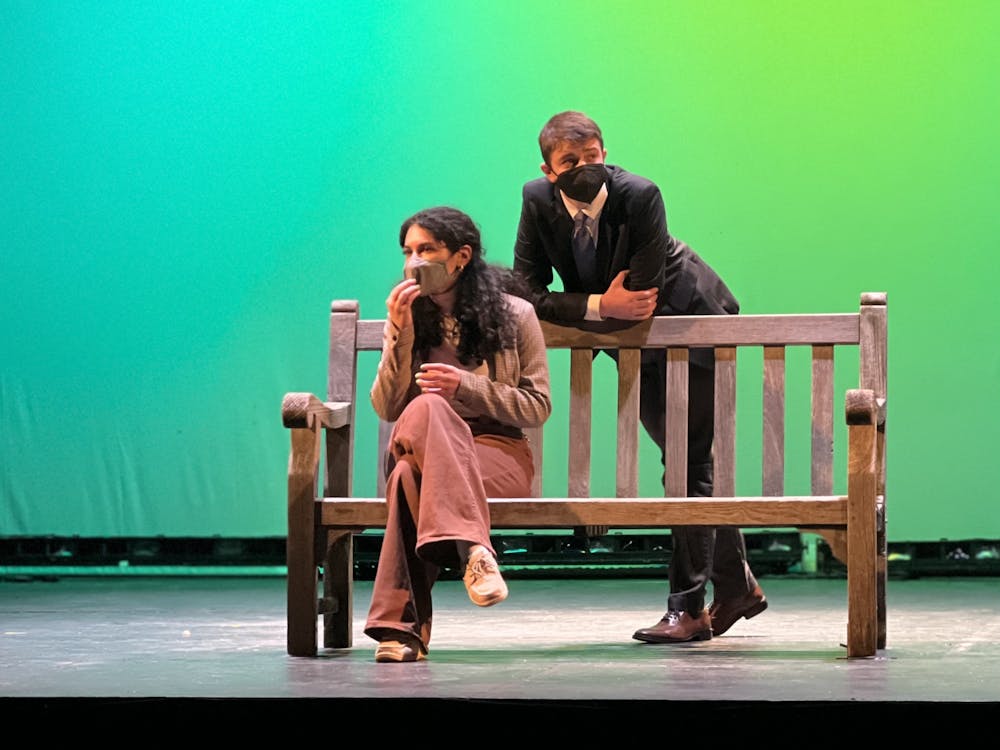Theatre Intime’s Freshman One-Act Festival (FOAF), which ran three performances this past weekend, captured what theater does best. Four short plays — each directed, acted, and produced by members of the class of 2025 — consider what it means to live a banal life, how to live in times of crisis, and what the medium of the stage can be. Great art poses more questions than answers. In that respect FOAF was a rollicking success.
“You’re Working the Checkout at Albertsons”
The first show, “You’re Working the Checkout at Albertsons” by Christian St. Croix, is an exercise in absurdism set in a grocery store. Four clerks speak in the second person and describe variously strange and mundane situations, each beginning “You’re working the checkout at Albertsons when …” Sometimes these disparate stories meander into philosophy or romance, dramatic fantasy or hypernormal realism. But the writing — pitched somewhere between “Welcome to Night Vale” and Tennessee Williams — is always matter of fact, painting all the stories in the same light: that of the painfully banal life of a cashier.
The actors, Fatima Diallo ’25, Ian Grimm ’25, Kate Stewart ’25, and John Slaughter ’25, set off the absurdism well. They describe stories in which “you” are the protagonist, and they deliver their lines as if they’re making them up on the spot. We see our stories being built up in front of us. And if there’s a theme through all these stories, it’s of feeling trapped within a basic, thoughtless existence: we watch the actors build cages around themselves through their stories. The play is about escaping banality, or at least desperately trying to find joy in it, both to no avail.
Emily Yang ’25 directs with a light hand: her four actors stay at their tills for essentially the whole of the scene’s 15-minute runtime. This makes the rare moments of movement, like Grimm stepping on his till and yelling “There is a sun!”, a pleasant shock. And playing out the show with “Once in a Lifetime” by the Talking Heads — with the refrain “Same as it ever was, same as it ever was” — is a nice touch.
Yang is an assistant web design and development editor for The Daily Princetonian.
“Joan of Arkansas”
The second show, “Joan of Arkansas” by Sheri Wilner, is a quiet call for hope. In a scene rich with metaphor, we watch two students — Dennis (Harit Raghunathan ’25) and Laura (Nathalie Charles ’25) — study in a library and hold a meandering conversation.
Raghunathan is a contributing puzzles constructor for ‘the Prince.’
The scene comes to an emotional climax when the conversation finds its way to a grim question: would you rather die or spend your life in prison? Dennis and Laura answer differently, and Raghunathan and Charles each present total certainty in their answers.
The show then shows itself to be a trial of hope: indeed, what is the response to suffering? Is it better to naively hope for the future or practice enlightened cynicism? The actors, under the discerning direction of Daniel Viorica ’25, force us to live in this dichotomy for the show’s length. In doing so, they force us to question our own perspectives. That’s what art should do, and this show does it well.
Viorica is an associate satire editor and The Prospect staff writer for the ‘Prince.’

“A Tale of Two Spectators”
The third show, “A Tale of Two Spectators” by Peter Manos, was the best of the bunch, in my opinion. We watch a man (Charlie Roth ’25) and a woman (Laura Reyes ’25) sit on a bench. They, in turn, are watching his wife and her ex-boyfriend, who are having sex in a public park.
Roth is an assistant data editor and staff news writer for the ‘Prince.’
We watch them watching them. Indeed Roth spends most of the show using a pair of opera glasses and staring out into the audience, looking at the adultering pair. Reyes even eats from a bag of popcorn. Roth happened to be looking straight at me in the audience for most of the show — I must have sat where the imaginary couple copulated. I couldn’t stop thinking about what it means to watch others. I was watching theater, and theater was watching me. I was off-put by the actors' voyeurism, until I realized that I occupied the very same role: what was I doing, sitting in the house, but watching a scene I probably shouldn’t be?
Roth played a low-tier wageworker; Reyes was a down-and-out loner trying to bum a smoke. Both of their relationships are, clearly, toast. But somehow these two, brought together by unfortunate circumstance, mesh over their shared plight. Aidan Iacobucci ’25 choreographed the action beautifully: the actors move synchronously, even in small leans and gestures.
Iacobucci is a staff news writer for the ‘Prince.’
Indeed Roth and Reyes together are a revelation. Roth’s realism, dry wit, and nasal deadpan mingle brilliantly with Reyes’s attitude, drama, and determination. They certainly put on a great show of peeping on the couple, but their best bit of acting is when the couple leaves, and they’re left alone. The actors engage in some supremely dry small talk — revealing what animated them all along.
“Medea”
The last show, “Medea” by Wendy Wasserstein and Christopher Durang, is a delectably excessive tangle with the classic. The show reads like a ragtag troupe of actors who read Medea a few years ago and tried to put it together from memory, played to hilarious effect.
It’s a colorful, abstracted collage of a play. Max Peel ’25 plays the lead, strutting around the stage in a mismatched pastel sweater and skirt. There’s a character named “Deus Ex Machina” who says she would have been flown in from the rafters, in a show with a bigger budget. Medea, wrought with guilt, lays down and shouts “I need a creative outlet!” The chorus at one point forgets what show they’re in and starts to perform “The Trojan Woman.”
The show ends — you can’t make this up — in song: a techno version of “Camptown Races” with new lyrics about not killing your kids, complete with party lights and dancing in the aisles.
Was it Euripides’s “Medea”? Of course not. But was it great theater? Absolutely. Titling a play “Medea” gives expectation — pretentious, literary expectation. Wasif Sami ’25 and Le’Naya Wilkerson ’25 direct a “Medea” that refuses to be traditional. It drips with wild élan. It’s the best “Medea” I’ve seen.
Theatre Intime’s season will continue later this month with “A Doll’s House,” Henrik Ibsen’s radical psychological play, directed by Ariel Rockman ’24. It opens Feb. 18.
Editor’s Note: This piece was updated to include a source’s position at the ‘Prince.’
Gabriel Robare is the co-Head Puzzles Editor. He is also a Senior Prospect Writer and a News Staff Writer. He can be reached at grobare@princeton.edu or on social at @gabrielrobare.








